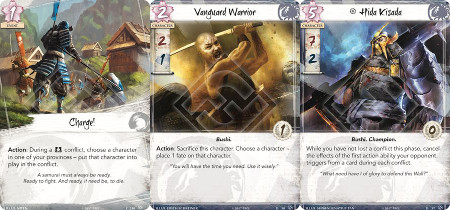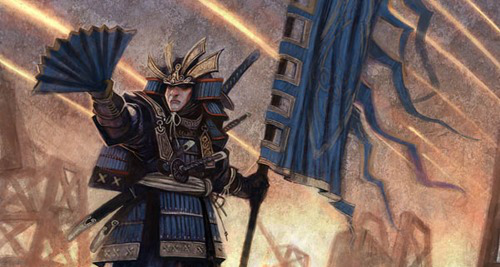Crab Tactica – The Dynasty Phase

I’ve been carrying out a number of experiments with different opening turns for Crab with the goal of ironing out inconsistencies, and it’s been bearing some fruit. One of the difficulties in L5R is the amount of brain power the game requires, especially over the course of a long tournament, so any automation where decisions are concerned is welcome. I’ve been tinkering with some different mulligan priorities and build strategies. These priorities shift depending on board state, and they do have exceptions, but I’ve found some general guidelines which are helpful in most situations. These aren’t big revelations and I’m not the first player to talk about them. These seem to be common conclusions from across the world that we saw at Worlds, Pax, and Madrid. They do form a solid foundation for new Crab players, and are a key start to this series of Crab Tactica.
Terminology:
Minor Characters: Cost 0-2 fate
Major Characters: Cost 3-5 fate
General Guidelines
Choosing whether to go first or go second:
Given the choice, go second. Crab focuses on subtle economic edges and every point of fate counts. Going second gives you one more fate and the first conflict on turn 2, which lets you grab another fate from a ring. The major exception to this rule is when you’re facing off against Lion, due to the threat of them attacking first with a Lion’s Pride Brawler. But even against Lion, going second may be the correct choice. Strictly, you don’t get to see your opponent’s stronghold before you decide, but often you’ll be familiar with your opponent or in the higher brackets will get to see their decklist first. If you’re comfortable with dealing with Lion’s Pride Brawler., you should likely go second, and facing a turn one LPB is a scenario that’s worth practicing against, because, more likely than not, you’ll have to face it in a tournament at some point.
Exception: Lion really, for the reasons stated above.
Pass first in the Dynasty Phase:
It gets you a valuable extra fate, denies your opponent a fate, and helps save fate in general. Unless the board state is urgent, you should always consider passing every time you get the option. You also want to make sure you have a fallback if your opponent passes before you, so always check your opponent’s dynasty options before you take an action during the Dynasty Phase. If your opponent has nothing attractive to build, he may pass before you, and you should try to make sure that your response is not a lame dejected “Pass.” Sometimes, it will be, but if your opponent does pass first, weigh your options and consider expanding your board. Passing early and often also leaves face-up personalities who are valuable Charge! fuel. Charging in a Vanguard Warrior may seem less epic and conflict-changing than Charging Hida Kisada, but you can still sacrifice the Warrior to place an extra fate on a key character.
Exception: When your fate stock is exceptional, still 5+ left to spend and some tempting characters worth investing in.

Try to finish the Dynasty Phase with at least 1 fate:
Hold on to at least one fate. Crab tends to play a fairly cheap conflict deck, but even so, at least half the cards in it will cost 1 fate. If you want to have all your conflict options available, then having 1-3 fate in your pool is ideal, and means that you can probably play all the relevant conflict cards from your hand that turn. If you don’t need to play any, then you will start the next turn with that much more fate.
Exception: You can break this rule if the board you develop from your Dynasty Phase is overwhelming, or if you are the first player and there is a decent stock of fate to harvest from a choice ring especially when that’s the ring you’re interested in this turn anyway.

Spending Fate
Going First:
Going first you get 7 fate to spend, since we don’t have a Seeker role, that is pretty much all you’re going to get on turn one. Maximising the value of that fate means investing in a board that will also support you on the following turn. Your mulligan targets are therefore a potent 3-cost character and a 1-cost character (and a holding or two doesn’t suck). A 1-cost character (ideally Kaiu Envoy, who refunds his cost) gives you an option to play Way of the Crab and is a speed-bump blocker at worst. The 3-cost character should have 2 additional fate placed on him, and then you should pass. This means you should definitely have 1 fate going into the first conflict, and hopefully, you’ll have 2. You can possibly swap the 3-coster for a 4-cost character like Steadfast Witch Hunter, but, assuming you’ve already purchased a 1-cost character, you then risk your opponent’s passing after taking a single action, which will leave you with no fate at all. Because competing for fate in early Dynasty Phases is so important, 1-cost conflict characters can be incredibly valuable.
Going Second:
Going second uses much the same tactics as going first, except that a 4-cost character isn’t a risk. Additionally, in your conflict mulligan, The Mountain Does Not Fall becomes a tremendous card and a high-priority keep, because it allows you to defend with your major character, and then possibly defend a second time, and still attack with them.
High Priority Mulligan Targets for the Dynasty:
Kaiu Envoy, Crisis Breaker, Stoic Magistrate, Borderlands Defender, Hida Guardian, Intimidating Hida. Going second includes the Steadfast Witch Hunter.

Later developments:
Continue to purchase major characters, placing 2 additional fate on them, and supplement them with minor characters with either 0 or 1 additional fate. Minor characters suitable for 1 additional fate include Shrewd Yasuki, Hiruma Yōjimbō, and Hida Guardian. These can be made with 0 fate, but usually, gain considerable additional value from being around for 2 turns. Vanguard Warrior, Kaiu Envoy, Hiruma Skirmisher, and Hiruma Ambusher are better off with 0 fate unless you badly need bodies.
Why 2 fate and not 1 fate on your Majors?
Every additional turn you keep a character on the board effectively rewards you with their value in fate. So, over two turns, a 3-cost character returns 6 fate-worth of value, and over three turns returns 9 fate. But a 3-coster with 1 fate only costs you 4 (returning 6), and a 3-coster with 2 fate costs you 5 (returning 9). This dynamic is affected by diminishing returns, since the game may only last 3-4 turns, but in general, 2 extra fate maximises value.
Two extra fate also denies your opponent an obvious Void Ring target on turn 1. Hammering your opponent’s characters with the Void Ring can generate tremendous board position and economic advantage, so you have to make it less attractive. Two fate also makes Meditations on the Tao less devastating if you stumble into it. You do want to protect these high-investment characters from targeted removal, but Reprieve and Iron Mine do an admiral job of that. Watch out for I Can Swim and Noble Sacrifice. The Feast or Famine province can really hurt, so be aware that Lion and Dragon typically run it.

Alright, that’s the intro to Crab Dynasty done. If you have any thoughts or suggestions please post below. Tune in next time for bidding and conflict selection.
If you have any comments or feedback please post them in the comments section below. Join us on our Twitch stream every second Monday at 8pm BST, 9pm CEST, 1pm PST.
Check us out on the Imperial Advisor website, podcast, and YouTube channel for more discussion about the L5R LCG.

5 Replies to “Crab Tactica – The Dynasty Phase”
Excellent article, Eoin :).
One of the best article I’ve ever read. Well explained, very interesting and equally helpful. Thank your for your effort. I look forward to reading the next one.
Great article. Thanks for taking the time to share it. Looking forward to the next one
How many people should youtarget to play each turn? 2? A 3-cost with 2 fate and one 1-cost?
I really like this breakdown, and have been enjoying your site a lot. Even though I’m not running Crab, the points you make here are helpful as an analysis style, and help both with thinking about opponents and re-measuring my own decks (currently working on building a strong Unicorn deck for a friend and re-tooling a Scorpion deck, so I’d love Tactica articles for those, too) 😉
Any recommendations for what to do if your mulligan doesn’t succeed? Say if you end up with three 2-cost minors and a 1-cost or a holding? How about other turn-1 conflict mulligan must-haves or toss-these cards?